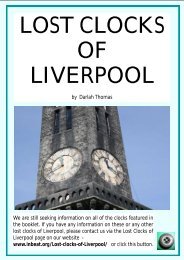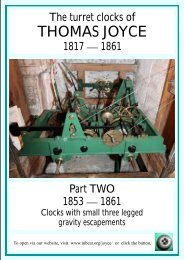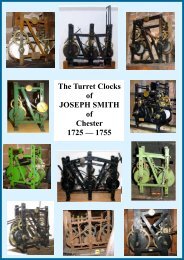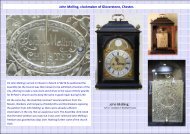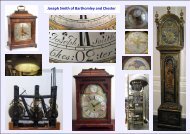An A to Z of Joyce clocks 1862-1965
You also want an ePaper? Increase the reach of your titles
YUMPU automatically turns print PDFs into web optimized ePapers that Google loves.
<strong>An</strong><br />
<strong>of</strong> JOYCE<br />
<strong>clocks</strong><br />
<strong>1862</strong> — <strong>1965</strong><br />
All types <strong>of</strong> turret clock made by <strong>Joyce</strong> <strong>of</strong><br />
Whitchurch, based on their location<br />
To open via our website, visit www.inbeat.org/joyce/ or click the but<strong>to</strong>n,
Ascot Racecourse 1896 – 2004<br />
The Bell Tower, Perth, Australia 2010 -<br />
This large three train clock with double three legged gravity<br />
escapement was installed at Ascot in 1896. It was au<strong>to</strong>-wound<br />
with a single mo<strong>to</strong>r in 1962, which the units above replaced in<br />
1992. In 2002 the grandstand was demolished and the clock was<br />
sold. It is now at The Bell Tower, Swan River, Perth, W Australia,
Bowell Patent Continuous Motion Clock 1930s<br />
Stable building, Private House, Shropshire 1933<br />
This clock was made under licence from George Bennett Bowel the patentee. It combined<br />
electrical and mechanical operation and was designed <strong>to</strong> be very accurate. It had a double three<br />
legged gravity escapement, which, unusually had no fly. Most <strong>of</strong> the production was exported <strong>to</strong><br />
Canada, but two were installed in the UK, only one <strong>of</strong> which has survived. This however has had<br />
all the Bowel components removed and is now driven by two mo<strong>to</strong>rs
Carnforth Railway Station 1895<br />
The movement<br />
cupboard<br />
The single train clock with pinwheel escapement is housed in the<br />
green cupboard seen in the <strong>to</strong>p picture left. The clock is fitted<br />
with an extra wheel which reduces the need for a tall weight drop.<br />
For a number <strong>of</strong> years the movement, dial and hands were lost<br />
after being replaced with an electric movement, but by a miracle<br />
were found again and reinstalled.
St Mary’s, Dudles<strong>to</strong>n, Shropshire 1865/6<br />
St Mary’s, Dudles<strong>to</strong>n has a two train clock with a small single four legged gravity escapement. It was<br />
given <strong>to</strong> the church by a local family in 1866, when it cost £100, see below left. The single four<br />
legged gravity escapement <strong>clocks</strong> were made in large numbers in single, two and three train versions,<br />
from late 1863 and throughout the 1870s and 1880s.
St Mary’s, Earls Bar<strong>to</strong>n, Northamp<strong>to</strong>nshire 1879<br />
This clock had been superseded by an electric clock when we visited a few years ago. The <strong>Joyce</strong><br />
clock had been kept safely in its cupboard and so remained in original condition.<br />
This church is a rare example <strong>of</strong> an <strong>An</strong>glo-Saxon<br />
building dating back <strong>to</strong> the late tenth century.<br />
Below: a close up <strong>of</strong> the escapement.
St Peter’s, Farndon, Cheshire 1874<br />
As the plaque below shows, the clock was gifted <strong>to</strong> the church by Emma Barns<strong>to</strong>n on the day <strong>of</strong><br />
her marriage. Her family had a long his<strong>to</strong>ry in Cheshire and were significant landowners in the<br />
area around Farndon. Their home, Crewe Hall was in the hamlet <strong>of</strong> Crewe-by-Farndon. The<br />
clock is <strong>of</strong> the two train, single four legged gravity type.
All Saints’, Gobowen, Shropshire 1948/9<br />
This was the last large three train, full quarter chiming clock made by JB <strong>Joyce</strong> & Co. Ltd. It was<br />
made by Tom Briscoe, uncle <strong>of</strong> Paul Fraser. It has a pinwheel escapement, although a double<br />
three legged gravity option would have been available.
Holyhead Railway Station & Harbour,<br />
This clock was made in 1880. The cast iron <strong>to</strong>wer<br />
was originally located almost adjacent <strong>to</strong> the harbour,<br />
as seen in the pho<strong>to</strong> at the bot<strong>to</strong>m <strong>of</strong> the page. The<br />
railway platforms were just out <strong>of</strong> shot <strong>to</strong> the left.<br />
At some time in the mid <strong>to</strong> late 20th century, the<br />
clock was removed and discarded outdoors in a<br />
remote part <strong>of</strong> the site. 1990 brought a re-modelling<br />
<strong>of</strong> the station and harbour complex and the <strong>to</strong>wer<br />
and clock were repaired and re-sited on the station<br />
approach. The position on a mini-roundabout meant<br />
that its former configuration had <strong>to</strong> be altered. What<br />
had been a meteorological panel became the<br />
entrance door for access <strong>to</strong> the clock (seen right) as<br />
the old door could no longer be used as ladder<br />
access would be unsafe so close <strong>to</strong> traffic.<br />
The single four legged gravity timepiece with short<br />
weight drop remains hand wound and is cared for by<br />
Stena Line who now owns the site.
St John’s, Ightfield, Shropshire 1866<br />
Ightfield is a small village south <strong>of</strong> Whitchurch with a beautiful Grade ll* listed church in the<br />
perpendicular style which dates back <strong>to</strong> the 14th century. Despite its small size, the church has a<br />
full three train movement with ting tang chiming and single four legged gravity escapement.
<strong>Joyce</strong> fac<strong>to</strong>ry clock 1902<br />
The <strong>Joyce</strong> Fac<strong>to</strong>ry timepiece - a single train, double three legged gravity escapement clock. This<br />
was the first clock <strong>to</strong> be au<strong>to</strong>-wound by the company - the design was by Paul Fraser. When the<br />
fac<strong>to</strong>ry closed, the clock remained in place and the new owners, auctioneer Trevanion & Dean<br />
have had it built in<strong>to</strong> the rostrum where it is hand wound and on view <strong>to</strong> visi<strong>to</strong>rs.
St Paul’s, Knowbury, Shropshire 1888<br />
The church has one <strong>of</strong> the last<br />
<strong>clocks</strong> with a single four legged<br />
gravity escapements <strong>to</strong> be made. We<br />
saw none dated 1889 or later<br />
although there were a few where the<br />
dates were illegible.<br />
When pho<strong>to</strong>graphed this clock was<br />
‘resting’ awaiting a visit <strong>to</strong> <strong>Joyce</strong>’s<br />
for an overhaul.
St Trillo’s, Llandrillo-yn-Edernion,<br />
Merionethshire 1878<br />
This early two train clock with pinwheel escapement is <strong>of</strong> the style adopted about ten years<br />
later; it lacks the decorative cut out detail seen on all the later pinwheel supports. Both clock<br />
and dial were in beautiful condition when we visited. This small village has border-hopped<br />
and is now in Denbighshire.
Hovis Showroom, Macclesfield 1937<br />
Hovis the baker had a presence in Macclesfield from 1886 when the company set up in Union Mill<br />
on the side <strong>of</strong> the Macclesfield Canal.. This building, which houses this clock is almost adjacent <strong>to</strong><br />
the mill and was built in 1937 for the Hovis Van Division where the company’s vans were finished in<br />
the Hovis livery and were also serviced on site. Since the company left, the building has had several<br />
owners. The clock is a pinwheel timepiece with only a six foot weight drop.<br />
We are<br />
grateful <strong>to</strong><br />
Barry<br />
Corbishley.<br />
For the clock<br />
pho<strong>to</strong>s.
St Mary’s, Nantwich, Cheshire 1892<br />
Records are scanty, but it is believed there were two <strong>clocks</strong> in the church dating back <strong>to</strong> 1661 and<br />
1763. This large three train clock which chimes Cambridge quarters has a double three legged<br />
gravity escapement.. A plaque on the clock records that it was supplied by John Palin <strong>of</strong> Nantwich<br />
and set going at Easter 1892. A brief look at the 1891 census on <strong>An</strong>cestry revealed that JP was a<br />
sixty year old watchmaker, glass and china dealer in the <strong>to</strong>wn. The clock is wound twice weekly.
Christ Church, Oxford 1889<br />
This large two train clock which strikes on the Great Tom bell, weighs 6 <strong>to</strong>ns, 4½ cwt. The clock<br />
was converted by Smith <strong>of</strong> Derby <strong>to</strong> be driven by electric mo<strong>to</strong>rs, so its original escapement had<br />
been removed. Its date suggests that it was probably a double three legged gravity from the<br />
outset, but we have found nothing <strong>to</strong> confirm this. A third mo<strong>to</strong>r drove the traditional ‘curfew<br />
<strong>to</strong>ll’ which strikes 101 times (one <strong>to</strong>ll for each <strong>of</strong> the 101 original students) at 9.05pm (9.05pm<br />
GMT, 9pm Oxford time), <strong>to</strong> warn students the college gates are about <strong>to</strong> be closed for the night.<br />
This heavy frame style was used when <strong>clocks</strong> had <strong>to</strong> strike on very large bells (as at Worcester).
Palé Hall, near Bala, Gwynedd 1871<br />
Palé Hall was once the country home <strong>of</strong> Scottish engineer Henry Robertson who made a fortune<br />
developing many <strong>of</strong> the railways in Wales and the border counties. The beautiful country house<br />
is now a hotel. The clock is ting tang chiming, with a single four legged gravity escapement which<br />
drives four dials. It has been fitted with a night silencing unit for the benefit <strong>of</strong> light sleeping<br />
guests.
St <strong>An</strong>drew’s, Quatt, Shropshire 1873<br />
(We haven’t visited yet!)<br />
This church has been on our list for a visit for a very long time. It has a <strong>Joyce</strong> clock which is<br />
believed <strong>to</strong> date from c. 1873 so it will most likely be a two or three train clock with a single four<br />
legged escapement. A person named Miss Carr gifted the clock <strong>to</strong> the church in memory <strong>of</strong> a<br />
family member.
Ruthin Castle, Ruthin, Denbighshire 1853<br />
(This clock is outside <strong>of</strong> our date range, but was <strong>to</strong>o individual <strong>to</strong> miss)<br />
This two train clock is one <strong>of</strong> the experimental <strong>clocks</strong> with pinwheel escapements made by<br />
Thomas <strong>Joyce</strong> in the 1850s. It was made during the same year as the last <strong>of</strong> the double frame<br />
<strong>clocks</strong> was made (for Coalbrookdale) and the first small single three legged gravity escapement<br />
clock was made (for the Savings Bank, Chester). None <strong>of</strong> the other experimental pinwheels<br />
resembles this one. When we visited, the clock was not operational but it appeared <strong>to</strong> be complete.
St Dominic’s Convent, S<strong>to</strong>ne, Staffordshire <strong>1862</strong><br />
This three train clock which chimes ting tang quarters is one <strong>of</strong> the small three legged gravity<br />
escapement <strong>clocks</strong> which James <strong>Joyce</strong> made after the death <strong>of</strong> Thomas <strong>Joyce</strong> in 1861. Several were<br />
made including those for churches at Over<strong>to</strong>n-on-Dee, Wrockwardine Wood, Menai Bridge,<br />
Montford and Mil<strong>to</strong>n Malsor. The last were made in 1863, which was the year when the first four<br />
legged gravity escapement <strong>clocks</strong> appeared.
St Chad’s, Tushingham near Whitchurch 1863<br />
We believe this two train clock in St Chad’s, Tushingham and one <strong>of</strong> the same date in the stable<br />
block <strong>of</strong> a country house were the first single four legged gravity escapement <strong>clocks</strong> <strong>to</strong> be made.<br />
Both are near <strong>to</strong> Whitchurch where James <strong>Joyce</strong>(2) would have been able <strong>to</strong> attend <strong>to</strong> any<br />
potential problems with the new escapement. This format proved very successful and was used<br />
on single, two and three train <strong>clocks</strong>, large and small, for twenty years, until superseded by the<br />
double three leg and pinwheel formats.
Vic<strong>to</strong>ria Institute, Worcester 1882<br />
Now at Worcester Museum & Art Gallery<br />
This four legged gravity timepiece<br />
was awaiting refurbishment for<br />
display when we visited. It was<br />
made for Canon Richard Cattley<br />
for his home where it drove one<br />
dial on the exterior for public<br />
view and two inside, one <strong>of</strong> which<br />
had a specially made dial by the<br />
Royal Porcelain Works, Worcester.<br />
In his will the Canon left the<br />
clock <strong>to</strong> the Vic<strong>to</strong>ria Institute<br />
which is now a museum and art<br />
gallery.
Worcester Cathedral 1869<br />
A plaque in the clock case records it was made by James and John Barnet <strong>Joyce</strong> in 1869. The clock<br />
has a very large three train, Westminster chiming mechanism with a double three legged gravity<br />
escapement. It is the earliest clock with this feature as this format was not routinely used by<br />
<strong>Joyce</strong>’s for another twenty years. It drives a slave dial in the ringing chamber and another in the<br />
North Transept, but, like many cathedrals, there was never an external dial.
St Deiniol’s, Hawarden, Flintshire Oct 1854<br />
(Like Ruthin Castle this clock is also outside our<br />
time-frame but could not be missed.)<br />
The clock at St Deiniol’s, Hawarden is one <strong>of</strong> a small group <strong>of</strong> experimental pinwheels made by<br />
<strong>Joyce</strong>’s in the 1850s. We have not seen another <strong>of</strong> this same design, but other trial examples were<br />
found at: Ruthin Castle, Denbighshire, 1852; Stan<strong>to</strong>n-upon-Hine Heath, Shropshire, 1854; and<br />
Bronning<strong>to</strong>n, Shropshire, 1859.
St Mary & St David, Y Fflint, Sir Y Fflint 1869<br />
(or Flint, Flintshire in English)<br />
This three train, ting<br />
tang chiming clock with<br />
a four legged gravity<br />
escapement was au<strong>to</strong>wound<br />
many years ago.<br />
It drives just one dial.
Hope Bowdler, Shropshire 1964<br />
The First and the Last ....<br />
It is not known whether<br />
there was an earlier clock in<br />
this old church <strong>to</strong>wer, but<br />
the clock illustrated dates<br />
back <strong>to</strong> 1964 when it was<br />
gifted <strong>to</strong> the church by Mary<br />
Ellen and Fanny Jones as a<br />
memorial <strong>to</strong> their family.<br />
This clock was the first <strong>to</strong> be<br />
made by <strong>Joyce</strong>’s which was<br />
intended <strong>to</strong> be au<strong>to</strong>-wound<br />
from the outset at the<br />
request <strong>of</strong> the two ladies. It<br />
has a pinwheel escapement<br />
and an au<strong>to</strong>-wind system<br />
based on the one designed<br />
by Paul Fraser and trialled on<br />
the fac<strong>to</strong>ry clock in<br />
Whitchurch.<br />
This clock was the last clock<br />
<strong>to</strong> be made by <strong>Joyce</strong>’s at the<br />
Whitchurch fac<strong>to</strong>ry. The<br />
following year the business<br />
was bought by Smith <strong>of</strong><br />
Derby and from then on the<br />
role <strong>of</strong> the Whitchurch work<br />
-force was <strong>to</strong> repair and<br />
service the <strong>clocks</strong> in their<br />
area and <strong>to</strong> work on heritage<br />
<strong>clocks</strong>.
All the <strong>clocks</strong> in this booklet feature IN GREATER DETAIL in our book JOYCE <strong>of</strong><br />
WHITCHGURCH Clockmakers 1690-<strong>1965</strong>. There is also the family genealogy and<br />
his<strong>to</strong>ries <strong>of</strong> each <strong>of</strong> the family’s clockmakers and <strong>of</strong> the company. The major part <strong>of</strong> the<br />
book is a pho<strong>to</strong>graphic record <strong>of</strong> over 150 <strong>of</strong> their turret <strong>clocks</strong>; our aim was <strong>to</strong><br />
pho<strong>to</strong>graph examples <strong>of</strong> each <strong>of</strong> the different models made by the company, but not all,<br />
as we would have had <strong>to</strong> visit between one and two thousand <strong>clocks</strong>! (The exact number<br />
was never recorded.)<br />
Hardback book 670 pages Over 1,500 illustrations, mostly in colour.<br />
SPECIAL PRICE until 31/12/20: £40 post free (normally £48 + £6.50 postage = £54.50)<br />
To buy the book at the discounted price, email us on steveanddarlah@inbeat.org<br />
Tell us you have read the booklet, and we will send you payment details.<br />
To see sample pages <strong>of</strong> the book visit www.inbeat.org/joyce/





